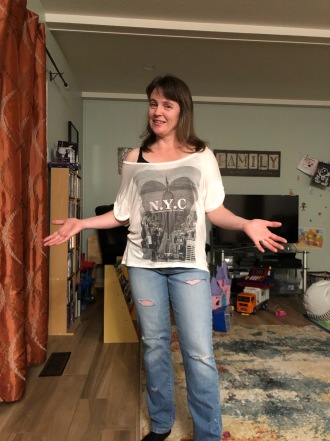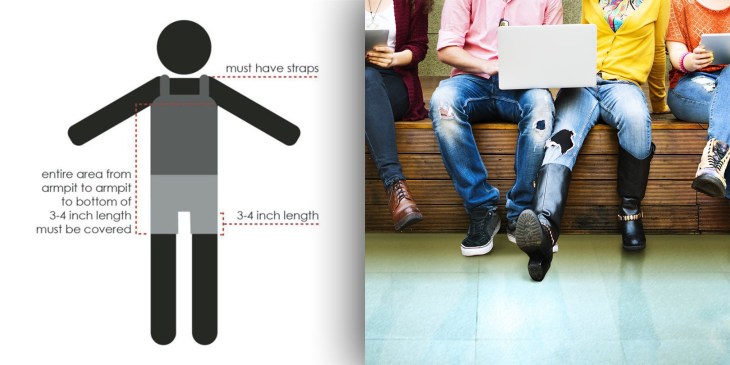
Dress codes which prohibit girls from wearing short shorts, spaghetti strap tops and just plain “show too much skin” are becoming a thing of the past. More and more students and parents in school districts throughout the United States are raising red flags and signing petitions urging school districts to change their dress code policies.
Schools with strict dress codes often claim that their regulations prevent in-class distractions, reduce pressures based on socioeconomic status, deter gang activity, and create a more academic learning environment. However, controversy is increasingly cropping up over whether excluding students from the classroom for violating dress code policies is worthwhile, and whether such rules are disproportionately enforced against girls, especially those of color.
Why such a fuss over clothes?
- Much of the controversy is related to the “cannot wear” clothing articles featured in many school district policies: Spaghetti strap shirts, tube tops, short shorts, mid-waist shirts, bra straps, low cut blouses. What do these all have in common? They all relate to girls clothing…not boys.
- Curvier or more developed girls are more likely to be asked to leave class to change than girls who don’t have these body features, because their body parts are more obvious. This can negatively effect a girls’ self esteem.
Many school districts have re-written their dress code policies in order to support equitable educational access. These policies are written in a manner that does not reinforce stereotypes of any group based on race, sex, gender identity, gender expression, sexual orientation, ethnicity, religion, cultural observance, household income or body type/size.
What do you think? Should I go to work in this?

Dress codes should probably address and reflect the culture of the school and be based on reality rather than assumptions or traditional thinking. For example: Does wearing a red article of clothing really promote a gang problem? Does a specific color create a gang problem or is poverty and a lack of social support creating the gang problem? I remember a time when the school I was working at had banned two or more articles of clothing from having blue or red on them. Fine, we will tell the kids to see the office staff if they have three articles of blue on. At the time I thought… how much you want to make a bet that the Latino student wearing three articles of blue would be sent to the office while the white student wearing five articles of red would not be talked to at all.
The girl with the flat chest is not going to be stopped by the teacher, but the girl with the large chest will be sent to the office in a heartbeat for wearing the V-neck shirt. Yep, this is kind of inequitable.
On the other hand: Do we allow students to students to assemble in gangs using their colors? Should students be allowed to dress irresponsibly and come to school looking like slobs? Does this promote a serious learning environment? By allowing students to come to school with holes up to their crotch, are we adults teaching students skills they need to know?… like the appropriate clothing in various social situations!
Here are some sample dress codes that work well to address all of these issues:
This one uses gender neutral clothing descriptions:
a) Students must wear clothing including both a shirt with pants or skirt, or the equivalent (for example dresses, leggings, or shorts) and shoes.
(b) Shirts and dresses must have fabric in the front and on the sides (under the arms).
(c) Clothing must cover undergarments (waistbands and straps excluded).
(d) Fabric covering breasts, genitals and buttocks must be opaque.
(e) Hats and other headwear must allow the face to be visible to staff, and not interfere with the line of sight of any student or staff. Hoodies must allow the face and ears to be visible to school staff.
(f) Clothing must be suitable for all scheduled classroom activities including physical education, science labs, wood shop, and other activities where unique hazards exist. (g) Specialized courses may require specialized attire, such as sports uniforms or safety gear.
The dress code further clarifies prohibitions on attire or grooming “depicting or advocating violence, criminal activity, use of alcohol or drugs, pornography, or hate speech;” defines parent, student, and staff responsibilities; and addresses appropriate enforcement.

..and what about school uniforms?
A lot of parents like them because it takes a lot of fuss out of clothing choices…but you can read the pros and cons here and you decide for yourself!
Pros and Cons on School Uniforms- https://school-uniforms.procon.org

Interesting post. I attended a private school until High School and loved having a uniform. Of course that is just anecdotal, but I just figured I would throw in my 2 cents!
LikeLiked by 1 person